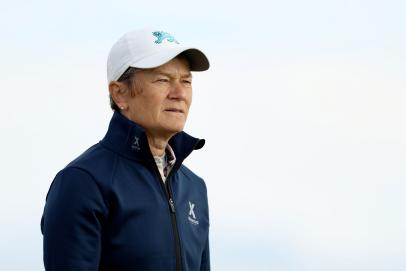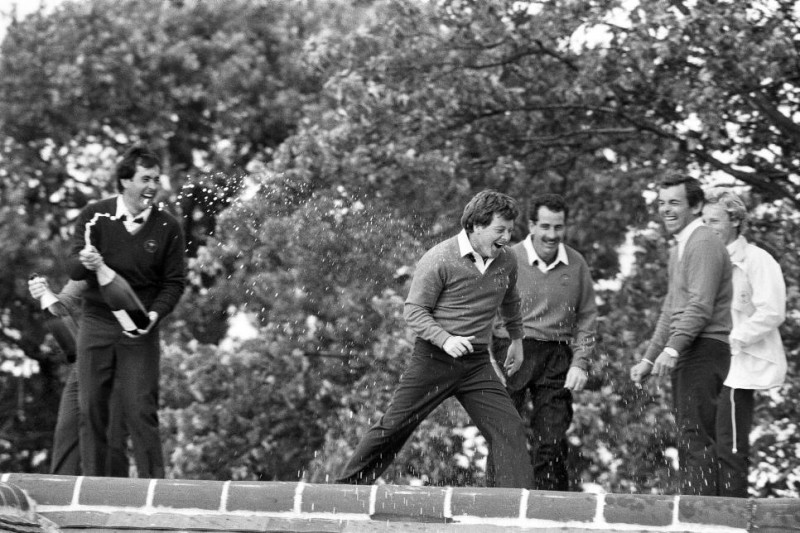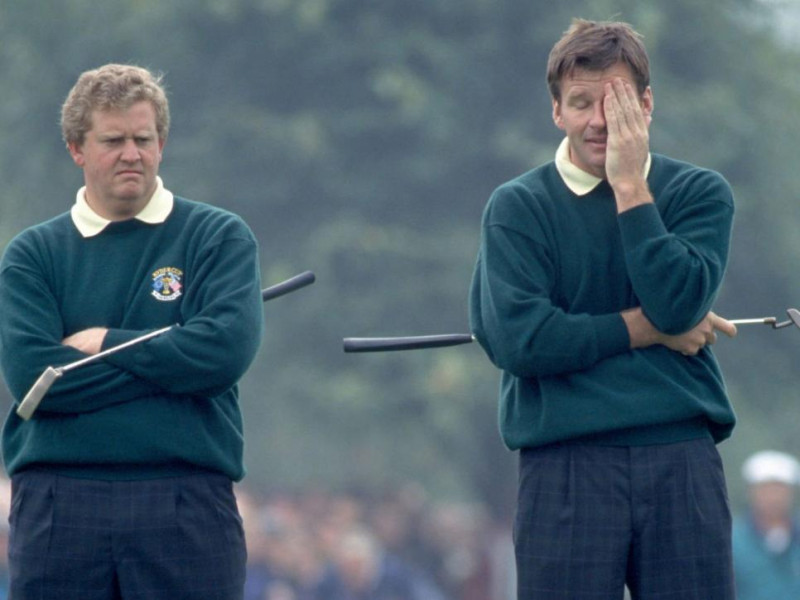SUTTON COLDFIELD, England — Almost half a century has slipped by since the beginning of a working relationship that continues today. It was in 1978 at a Hennessy Cognac Cup match between a Great Britain & Ireland team and one from the Continent of Europe that a 21-year-old Nick Faldo first played competitively at The Belfry. And now, 46 years on, the now Sir Nick is hosting the Betfred British Masters at the same venue, but on a course that has seen much change and improvement over the passage of time.
“The course was sparse in the early years,” he says. “At first, it was a field with saplings everywhere. We used to call it the ‘Ice Valley’ because it was so cold. There was no shelter from the wind. Now they have a million trees to help with that.”
Still, at age 67, in common with just about anyone closing in on a 70th birthday, Faldo’s recall isn’t quite what it was. So Golf Digest jogged his memory with the help of the program from that Hennessey Cognac Cup, the 1984 Lawrence Batley International and the 1985, ’89 and ’93 Ryder Cup matches.
“The image on the cover of that program haunts me still,” said Faldo of the action he had in 1978. “It wasn’t terrible. I did win three PGA Championships in four years and five times in 1983 swinging like that. But I had to work so hard on tempo and timing. That was key back then. It just wasn’t reliable under the severest pressure, as I discovered on the back nine of the 1983 Open at Birkdale. I just couldn’t handle the position I found myself in.”
Looking back, Faldo has no regrets about making the swing change that would see him win six majors between 1987 and 1996. But what he does rue is the fact that, were someone to go through a similar transformation today, the process would be a lot quicker. Three years separated Faldo’s last pre-change victory and his first, the 1987 Spanish Open, afterwards.
More From Golf Digest
 Game Recognize Game
'Is this the best golf swing you've ever seen?': Nick Faldo pays huge compliment to rising star
Game Recognize Game
'Is this the best golf swing you've ever seen?': Nick Faldo pays huge compliment to rising star
 Glory's Cost: Will money ruin the chase for golf greatness?
Glory's Cost: Will money ruin the chase for golf greatness?
 Ready to lead
Zip lines, axe throwing and confidence boosting: Catriona Matthew is all in for her Curtis Cup captain debut
Ready to lead
Zip lines, axe throwing and confidence boosting: Catriona Matthew is all in for her Curtis Cup captain debut
“I can’t say I look back and wonder how far I could have gone with that old swing,” he says. “I had to change it when the little voice inside told me I just wasn’t good enough. I was thinking about it all through 1984 and I went three full years without winning from May 1984 to May 1987. Brutal.
“The thing is I wouldn’t have to do what I did back then,” he continues. “Now I’d just live on Trackman every day. The information I would get would accelerate the process. Just this week I was on a range in Copenhagen. I hit six balls with ‘Tracy’ on AI telling me what to do. Then I hit the seventh ball to a foot. If you’re smart, that’s how you do it. I wouldn’t have to hit anything like the number of balls I did hit. It must have been millions. Today, it would have been a lot less painful.”
For all that the Hennessey memory might make him shudder, Faldo did have a small role to play in an historic moment, one that is talked about even now. One up on the 10th tee, Seve Ballesteros drove onto the distant green en route to a 2-and-1 victory over Faldo. A plaque commemorates the occasion and so, in his own single-minded way, does Faldo, his attention still on that cover picture.
“I do remember Seve driving the 10th green,” he says. “Who could forget that? But that’s about all I have. I’m like most people; I don’t tend to remember the losses. But that cover. The old willowy swing to a tee.”
Moving right along, Faldo’s failure to be at The Belfry to defend the Lawrence Batley International title he won in 1983 does provoke one revealing anecdote.
“Over the course of my career, I threw the towel in twice,” he reveals. “Once when we went to Spain and the course was horrendous. And the second time was halfway through the 1983 Batley, when I won at Bingley St. Ives. I was miles behind at the halfway stage. And it was right after the Open that upset me so much. Nothing was happening and I gave up on the Friday. It was ‘sod it, who cares, let’s go home.’ But I somehow made a couple of late birdies and made the cut. Then I shot 64-62 on the weekend and won. That taught me a lesson. No more giving up.”
Which brings us to the 1985 Ryder Cup, what was perhaps the nadir of Faldo’s golfing journey. Two months into his swing change, he was a pointless passenger as Europe won the trophy for the first time. If you look at all the pictures of the players celebrating on the roof balcony at The Belfry, there is no sign of Faldo. As the likes of Ballesteros, Bernhard Langer and Sam Torrance sprayed champagne over the huge crowds below, Faldo was in the room behind them.

Europe's first Ryder Cup win on American soil in 1985 was cause for celebration, but Nick Faldo was nowhere to be found, disappointingly not winning a point while in the midst of a swing overhaul that would ultimate change the course of his career.
Mirrorpix
“I didn’t do my bit,” he says. “Tony [Jacklin] had picked me even though I was going through the swing stage. He told me I could be a chameleon and that I could get it done. But I couldn’t. I lost my first match and told Tony not to play me again. I was no good. That was a horrible feeling. Then I lost to Hubert Green in the singles. I just didn’t do my bit. It was terrible. I know everyone preaches the team ethic these days. But I didn’t feel part of it. I just didn’t do my bit. Even if you get half a point you feel part of it. But I got zero and played crap.
“I didn’t regret being there,” he continues. “I always had great belief that I could do it. I had that feeling every week, or at least that it will be a little better. But then I kept getting my head kicked in. My swing had just been torn up. I had a new backswing with an old follow through. Good luck.”
Happier Belfry days were ahead though. Four years later, Faldo was back as Masters champion, his partnership with Ian Woosnam, which began two years earlier at Muirfield Village, a potent weapon in the European armory, the match finishing in a draw.
“1989 was a lot more fun,” Faldo confirms. “Me playing with Woosie was brilliant. We had been so good in ’87 and it carried on here. The golf was good. My attitude was great. And the scoring was amazing. That changed at Muirfield Village in ’87. It used to be that, if you shot one under in foursomes you won. Then it went to four or five under. We suddenly found out how to play foursomes properly.
“Famously, Woosie and I were 11 under against Zinger and Chip Beck in a four-ball—and lost,” he continues. “It was the start of a new era. ‘You ain’t going to win if you are only 10 under, mate.’ Or you might not win. I remember hearing Bubba Watson complain about being 10 under and losing. My only thought was ‘tough shit mate.’”
Four more years on, Faldo was back for what would be the ninth of his eventual 11 Ryder Cup starts. By that stage he was well established as the great player he had become, the swing re-build long ago completed. And this time he had a new partner in Colin Montgomerie.

Playing his ninth Ryder Cup, Faldo was the veteran trying to show Colin Montgomerie, competing in the matches for just the second time, the ropes in 1993 at The Belfry.
“In 1993, I was looking after Monty,” says Faldo with a smile. “Which was hilarious. I remember none of the sweaters seemed to fit. We had to go to the pro’s shop, Monty and I. The sleeves were the wrong length. The Americans and the other Europeans were wearing cashmere, and we had to make do with lambswool. Oh my goodness.
“Monty hits fades all the time, as most people know,” he continues. “So the plan was for me to drive on all the ‘draw’ holes, which included the first. Anyway, I went on the range that first morning and just could not hit a draw. As we walked to the tee, I told him he had the first drive. His face was a picture. So funny. But we played well.”
There was more fun and games too, before the Americans clinched what remains their last victory on European soil. In his singles match with Paul Azinger, Faldo was over a five-foot putt on the 16th green (two holes after making a hole-in-one) at the very moment the trophy was officially won.

'The image on the cover of that program haunts me still.' (Photo by Ross Kinnaird/Getty Images)
“So I said to Paul, ‘you might as well give me this,’” Faldo says. “And he did. Then I birdied the 17th to go 1 up. But he made a birdie on the 18th to get the half point.”
Indeed, a lot happened at The Belfry for Faldo in the 15 years between 1978 and 1993. The course changed a lot and so did he. And now, many years later, there are mixed—albeit tongue-in-cheek—feeling about it all from the six-time major champion.
“So yes, I’ve had a long relationship with The Belfry,” says Faldo says. “Forty-six years. I hate that in a way. My stories are getting too old. But I’ve loved being here over the years. The Belfry and I have both done very well out of the Ryder Cup.”
Top photo by Ross Kinnaird/Getty Image